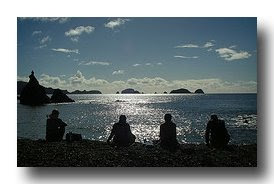We’re in kauri country. We’ve traveled New Zealand’s kauri country since we turned southwest near Mangamuka Bridge and dropped into the Hokianga. Kauri, a conifer and one of the world’s largest trees, grows in this warm northern part of New Zealand. At one time, kauri spread from Northland to the Coromandel Peninsula south of Auckland. Today, the majority of kauri are in the Hokianga region.
If you hang around with an Aussie, they’ll tell you the bush is the outback. In New Zealand, the bush is a forest– a thick forest layered with trees, shrubs, vines and ferns. You don’t want to and probably can’t get far off the path. Even though there’s no poisonous creepy crawly things in New Zealand, you might run into a weta– a large scary-looking cricket who thinks you’re large and scary-looking, or a friendly fantail. About the size of a chubby sparrow with an apricot breast and white ear patch. He’ll tag along and zip past your nose, then sit on a branch and spread open his tail for you to admire. Don’t count on a weta or fantail to lead you through the bush. Stay on the path.
Te Matua Track is posted from Hwy 12. Once in the carpark, you’ll find signs for Te Matua Ngahere, Father of the Forest. A 20-minute walk from the carpark, Te Matua, the second largest living kauri in New Zealand, is believed to be over 2000 years old. All kauri have sensitive surface roots. You’ll find viewing platforms and wooden walks around kauri. From this same carpark, you can visit the Four Sisters with their evenly spaced slender trunks joined together at the base.
Spend an evening in the forest with the night critters. You’ll find DOC camps near the Tasman Sea or inland at Trounson Kauri Park. Trounson campsite is serviced and booked at any DOC Visitor Centre. DOC has three types of campsites. Standard and basic can’t be booked. There’s a Top 10 Holiday Park nearby. If you’re traveling by car and not camping, book a room at the Holiday Park. We’ve talked about these parks before and their discount cards. Wherever you stay, you can book a guided night walk with the Top 10 Holiday Park. They’ll take you on a night walk through the kauri where you might see weta, glow-worms, Moreporks– tiny New Zealand owls that sing through the forest once the sun goes down– or a kiwi.
Spend any amount of time in a kauri forest and you’ll understand:
The Last Kauri
“Artist Rei Hamon was once manager of the Thames Sawmilling Company and had the job of supervising the felling of a large kauri above Tapu in 1961. He recalls, “When that tree fell, it had been standing there for maybe a thousand years...I went back later to where it had been standing, and there were birds fluttering around there, kaka and kereru, that had nested in that tree for generations. That was the finish. I handed in my resignation. I vowed never to fell another healthy tree.”
Quote from:
Joanna Orwin, Kauri: Witness to a Nation’s History. Auckland: New Holland, 2004, p.174
Lyn Harris
RV in NZ: How to Spend Your Winters South in New Zealand
+
+copy.jpg)
+copy.jpg)
+copy.jpg)
+copy.jpg)
+copy.jpg)
+copy.jpg)









 Photo By
Photo By







+copy.jpg)
+copy.jpg)
.jpg)
+copy.jpg)
+copy.jpg)

















+copy.jpg)



